
Outline
A system of classification of horse coat colors and markings is important in any program of identification of horses as individual animals. To have accurate and uniform application of the terminology for color classes, the system should stress recognition of basic, definable characteristics and should minimize the importance of subtleties which cannot be clearly defined. A scheme of coat color classification based on recognition of the effects of the alleles of seven genes provides the necessary rigor, and with training can be uniformly applied by anyone to define most of the common colors encountered in horses.
In order to understand coat color genetics, one must first learn to pick out the conspicuous characteristics affected by each gene. This can be likened to observation and study of a basket of mixed fruit. At first glance we may see a melange of shapes, colors and textures, but with a second glance the trained eye can see the distinctive presence of apples, oranges and bananas. Similarly, the potpourri of horse colors can be focused into a structured subject by attention to the effects of seven different genes.
Every cell contains a duplicate set of genes. Each set is derived from the single gene sets contributed at conception by both the mother and the father. The gene sets contain similar, but not necessarily identical, information. For example, both sets may contain a gene determining hair structure, but one set may contain the instructions for straight hair and the other for curly hair. The alternative forms of each gene are called alleles. If both alleles are identical, then the animal is said to be homozygous at that gene; if the alleles are dissimilar, then the animal is said to be heterozygous at that gene. Information about the homozygosity or heterozygosity for various genes can be inferred from information about parents and/or progeny and can be used for predicting the outcome of matings. For most of the alleles of horse coat colors one cannot tell by looking at an animal whether it is homozygous for any coat color gene, so zygosity information will not be critical for purposes of identification. Sometimes, however, information about coat colors of parents may be used as an indication of incorrect parentage or erroneous identification, so some familiarity with genetic relationships may be useful.
Both sets of genes function simultaneously in the cell. Often when the gene pair is heterozygous, one allele may be visibly expressed but the other is not. The expressed allele in a heterozygous pair is known as the dominant allele, the unexpressed one as the recessive allele. The term dominant is given an allele only to describe its relationship to related alleles, and is not to be taken as an indication of any kind of physical or temperamental strength of the allele or the animal possessing it. Likewise, possession of a recessive allele does not connote weakness.
For simplicity in constructing models, geneticists symbolize genes by letters such as A, B and so on. A dominant allele of a gene can be symbolized by an italicized capital letter, e.g., A, and the recessive by an italicized lower case letter, e.g. a. For each of the seven genes of horse coat color to be considered, only two alternatives will be considered.
In any animal expressing the dominant allele of a gene, it cannot be determined by looking at the animal whether the second allele is a dominant or a recessive one. The presence of a recessive allele may be masked by a dominant allele, which leads to the expression "hidden recessive." Dominant alleles are never hidden by their related recessive alleles.
In the presence of the dominant allele W, a horse from birth will typically lack pigment in skin and hair. The skin is pink, the eyes brown (sometimes blue), and the hair white. Such a horse is termed white (Fig. 1A). Sometimes such a horse is called albino.
The W allele is only rarely encountered. All non-white horses are ww.
A young horse with a G allele will be born any color but gray and will gradually become white or white with red or black flecks as an aged animal. Earliest indications of change to gray can be seen by careful scrutiny of the head of a young foal, since often the first evidence of the gray hairs will be seen around the eyes (Fig. 1C). In intermediate stages of the graying process, the horse will have a mixture of white and dark hairs, a most confusing stage for trying to identify color.
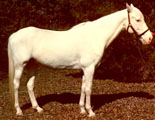 |
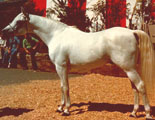 |
 |
| Fig. 1A | Fig. 1B | Fig. 1C |
Fig. IA - Dominant white (Ww). This horse has been white from birth. Note pink skin, clearly seen around mouth, nostrils, eyes. Eyes are brown in this horse and most white horses, but occasionally may be blue.
Fig. 1B - Gray (G). This gray Arabian stallion was foaled a non-gray color and turned white with age. In comparison with Ww horse, note black skin around mouth, nostrils and eyes.
Fig. 1C - Gray (G) pony mare with her red tobiano foal turning gray (Gg, ee, TOto). Note rings around eyes of gray hair interspersed with red color. When mature, it will not be obvious that the foal was red at birth, and the spotting will only be evident as a pink-skinned pattern in the skin.
In contrast to white (W) horses, gray horses are born pigmented, go through lightening stages, but always contain pigment in skin and eyes at all stages of coloration change.
A gray horse will be either GG or Gg. It is not possible to tell by looking at the horse whether it is homozygous for G. For simplicity in notation, a horse expressing a dominant allele can be symbolized as, for example, G. Use of a single allele designation in this paper for color assignment implies that no information about the second allele of the pair is available. All non-gray horses will be gg. For homozygous recessive colors, both alleles are written in the notation for color assignment, since a horse showing a color or pattern produced by recessives is by definition homozygous for the recessive alleles.
Since gray is produced by a dominant gene, at least one parent of a gray horse must be gray. If a gray horse does not have a gray parent, then it should be seriously considered that the purported parentage is incorrect.
If an animal has no black pigmented hair, it has the genetic formula ee. Basically, an ee animal will be some shade of red ranging from liver chestnut to dark chestnut (Fig. 1 D) to chestnut (Fig. 1E), or sorrel (Fig. 1F). Manes and tails may be lighter (flaxen), darker (not black), or the same color as the body. These pigment variations of red cannot yet be explained by simple genetic schemes. Furthermore, the shades of red are not consistently defined by breeds or regions of the country, so usage of specific terms for the shades of red can be confusing. For discussion purposes this group of colors is lumped under the term red.
Since the red animal is not gray and not white, its genetic formula in terms of the three genes discussed so far is ww, gg, ee. Notice that when two red horses are bred together (ww, gg, ee x ww, gg, ee), the offspring should also be red (ww, gg, ee). If the offspring has black pigment (E) or is gray (G) or white (W), then the parentage as given is most likely incorrect.
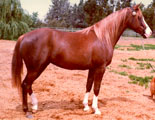 |
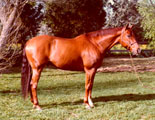 |
 |
 |
| Fig. 1D | Fig. 1E | Fig. 1F | Fig. 1G |
Fig. 1D - Dark chestnut (ee). Arabian mare, Tamasina. For purposes of identification, this color as well as the next two (E, F) are best referred to as red in order to avoid differences in regional and breed specific terminologies for the red series.
Fig. 1E - Chestnut (ee). Thoroughbred gelding, Mr. Maz Jr. For identification puposes this color should be called red.
Fig. IF - Sorrel (ee). Thoroughbred gelding, Flying Comedian. This horse is registered as a chestnut, but Western regional terminology would describe this light color variant as sorrel. In order to avoid confusion, the use of the term red is preferred.
Fig. IG - Bay (A, Ee). Arabian stallion, Aurtal. (Michael Bowling photograph).
The alternative allele a does not restrict the distribution of black hair and thus in the presence of the allele E of the E gene a uniformly black (Fig. 1H) horse is produced. In most breeds of horses, the a allele is rare, so black horses are infrequently seen. Many black horses will sun-fade, especially around the muzzle and flanks and such animals may be called brown. The term brown can be used for several genetic combinations (various reds, bays and dark bays (Fig. 1I), as well as some blacks).
Neither A nor a affects either the pigment or its distribution in red (ee) horses. Thus it is not possible to determine by examination of coat color which alleles of the A gene a red horse has.
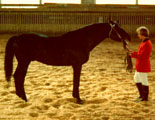 |
 |
| Fig. 1H | Fig. 1I |
Fig.IH - Black (aa, E).Trakehner stallion.
Fig. 1I - Dark bay (A, E). Arabian mare, Narah Bint Neziah. This color may variously be called dark bay, black bay, mahogany bay or brown. In order to obviate confusion, it is suggested that the basic color be described simply as bay in recognition of the black pigment in an obvious points pattern.
In homozygous condition, CcrCcr completely dilutes any coat color to a very pale cream with pink skin and blue eyes. Such horses are often called cremello (Fig. 2C), also perlino or albino. Typically, such horses are the product of the mating of two dilute-colored animals such as palominos or buckskins. Cremello may be difficult to distinguish from white unless critical judgments can be made about hair color. The hair of CcrCcr animals will be cream-colored, whereas the hair of W horses will be white. As with W and G horses, for CcrCcr horses it is not possible to determine which alleles of other genes are present.
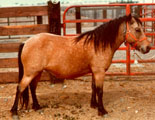 |
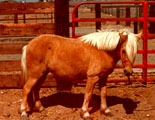 |
 |
| Fig. 2A | Fig. 2B | Fig. 2C |
Fig. 2A - Buckskin (A, E, CCcr ) pony mare. Note that this horse is basically a bay, but the areas of red pigment have been diluted to yellow.
Fig. 2B - Palomino (ee, CCcr ) pony mare. The presence of a dilution gene dilutes red pigment to yellow.
Fig. 2C - Cremello (CcrCcr) pony mare. Compare with figures of Ww and G horses. Note the cream-colored hair, pink skin and blue eyes as the group of special characteristics of cremello.
This pigment dilution pattern is called dun. In an otherwise red horse, the D allele produces a pinkish-red horse with darkened points known as a red dun or claybank dun (ww, gg, ee, CC, D). In an otherwise bay animal, the D allele produces a yellow or yellow-red animal with black points known as a buckskin dun (ww, gg, E, A, CC, D) (Fig. 2D). An otherwise black animal with the D dilution allele is a mouse gray color with black points known as a mouse dun or grulla (ww, gg, E, aa, CC, D).
The effect of D and Ccr can be easily confused in A, E horses so care must be taken in identification. It is possible for an animal to have both the Ccr and D dilutions, a situation which may be difficult to distinguish except by breeding tests.
D is found only in a few breeds of horses, and probably in the United States would only be seen in stock horse breeds, as well as in some ponies.
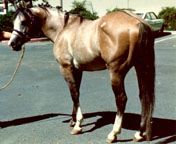 |
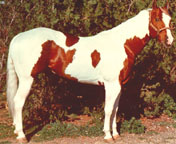 |
| Fig. 2D | Fig. 2E |
Fig. 2D - Buckskin dun (A, E, D). Compare with buckskin (A, E, CCcr). Note the dun pattern (dorsal stripe, shoulder patch, leg barring on front legs) associated with the D dilution factor.
Fig. 2E - Red tobiano (ee, TOto) Paint stallion, Dandy Diamond.
 |
 |
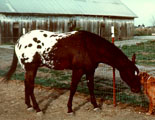 |
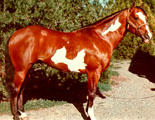 |
| Fig. 2F | Fig. 2G | Fig. 2H | Fig. 2I |
Fig. 2F - Blue eye on a bay pony mare.
Fig. 2G - Red (ee) roan Quarter horse mare, Miss Bar Depth and her red roan foal, Pepermint Pati Kid.
Fig. 2H - Black (aa, E) Appaloosa stallion, Twice as Bright.
Fig. 2I - Bay (A, E) Paint overo stallion, Forecast Too.
Defining the coat color of a horse is a stepwise process. The first step is to determine if either G or W is present. If yes, then the animal is gray or white and this is the end of the identification task.
If the horse is neither gray nor white, then assignment of alleles of the other genes can be made to define the color. First, one must decide if the horse has E. When E is present, then it must be decided whether the horse has A. If the animal does not have E, then a decision about A cannot be made. If none of the colors is diluted and if no spotting pattern is present, these decisions about E and A will define the colors bay, black and red.
If dilution of the basic colors to yellow, light red, mouse gray or cream is present, then further definition can be made with addition of the alleles of C and D to the basic formula containing W, G, E and A. In the absence of white spotting these decisions will define the colors palomino, buckskin, cremello, red dun, buckskin dun and mouse dun.
If a white spotting pattern is present which meets the definition of tobiano, TO can be assigned to the genetic formula.
The outcome of decisions about the genes W, G, E, A, C, D and TO results in the assignment of alleles for each gene. Each assignment should be carefully reviewed to consider if the chosen alleles are likely to be found in the breed of horse being identified.
Some of the genetic formulas and their color definitions which can be assigned by this process are shown in Table 1.
Genetic Formulas and Color Definitions | |
|---|---|
| Genetic Formula | Color |
| W | White |
| G | Gray |
| E, A, CC, dd, gg, ww, toto | Bay |
| E, aa, CC, dd, gg, ww, toto | Black |
| ee, aa, CC, dd, gg, ww, toto | Red |
| E, A, CCcr, dd, gg, ww, toto | Buckskin |
| ee, CCcr, dd, gg, ww, toto | Palomino |
| CcrCcr | Cremello |
| E, A, CC, D, gg, ww, toto | Buckskin dun |
| E, aa, CC, D, gg, ww, toto | Mouse dun |
| ee, CC, D, gg, ww, toto | Red dun |
| E, A, CC, dd, gg, ww, TO | Bay tobiano |
| ee, CC, D, gg, ww, TO | Red dun tobiano |
The final step in the coat color identification process is to add any other pertinent markings and patterns to the description such as face and leg markings, roaning, appaloosa and other spotting. Using the genetic system for coat color identification, most of the colors found in horses can be identified. Horses whose color cannot be defined may rarely be encountered, but a systematic appraisal of the genes likely to be found will provide a better identification than descriptive adjectives lacking a defined basis.
Alleles and Actions of Horse Coat Color Genes | ||
|---|---|---|
| Gene | Alleles | Observed Effect of Alleles in Homozygous and Heterozygous Condition |
| W | W
w |
WW: Lethal
Ww: Horse typically lacks pigment in skin, hair and eyes and appears to be white. ww: Horse is fully pigmented. |
| G | G
g |
GG: Horse shows progressive slivering with age to white
or flea-bitten, but is born any non-gray color. Pigment is always present
in skin and eyes at all stages of silvering.
Gg: Same as GG. gg: Horse does not show progressive silvering with age. |
| E | E
e |
EE: Horse has ability to form black pigment in skin and
hair. Black pigment in hair may be either in a points pattern or
distributed overall.
Ee: Same as EE. ee: Horse has black pigment in skin, but hair pigment appears red. |
| A | A
a |
AA: If horse has black hair (E), then that black
hair is in points pattern. A has no effect on red (ee)
pigment.
Aa: Same as AA. aa: If horse has black hair (E), then that black hair is uniformly distributed over body and points. A has no effect on red (ee) pigment. |
| C | C
Ccr |
CC: Horse is fully pigmented.
CCcr: Red pigment is diluted to yellow; black pigment is unaffected. CcrCcr: Both red and black pigments are diluted to pale cream. Skin and eye color are also diluted. |
| D | D
d |
DD: Horse shows a diluted body color to pinkish-red,
yellow-red, yellow or mouse gray and has dark points including dorsal
stripe, shoulder stripe and leg barring.
Dd: Same as DD. dd: Horse has undiluted coat color. |
| TO | TO
to |
TOTO: Horse is characterized by white spotting pattern
knoiwn ads tobiano. Legs are usually white
Toto: Same as TOTO toto: No tobiano pattern present. |